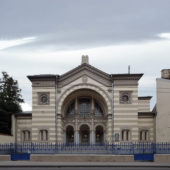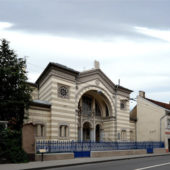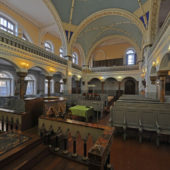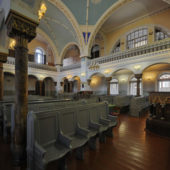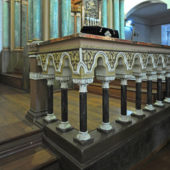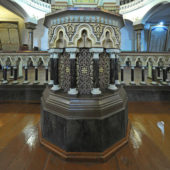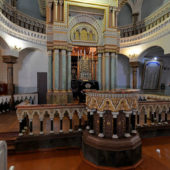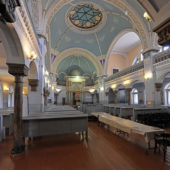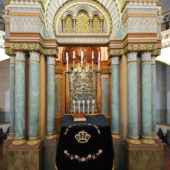The sole remaining synagogue in Vilnius where once there were 105 synagogues and prayer houses serving a population of nearly 100,000 Jews.
Jews were invited to Vilnius and granted privileges by the Grand Duke Gediminas 14th century, because the Grand Duchy of Lithuania was in need of craftsmen, merchants and financiers. They came from Cologne, Krakow, Danzig, and Frankfurt amongst other cities and countries. The Jews prospered in Lithuania and their numbers continued to increase. In fact, just prior to WWII, Vilnius was 40% Jewish, with a community of 80,000 members. At one time the city’s Jewish population was 100,000, with 105 synagogues and prayer houses. At the beginning of the 21st century there are approximately 4,000 Jews in the country, most of whom live in Vilnius.
The famous 18th century Hebrew scholar Elijah ben Shlomo Zalman came from Vilnius. He was considered a genius or “gaon” and Gaono Street in Vilnius is named after him. The old Jewish Ghetto in Vilnius had eleven synagogues on just one street at the same time!
Nearly the entire Jewish community of Vilnius, as well as the synagogues, perished during the Holocaust. The Choral Taharat Ha Kodesh is the only remaining Synagogue in Vilnius. It is referred to as the “Choral Synagogue” because it has a choir section, which was revolutionary for this time period. The Nazis occupied this Synagogue during WWII, which is why it wasn’t destroyed along with the others. At the Synagogue, there is a monument to the Japanese Consul, Chiune Sugihara, who rescued Jews during the Holocaust. Many of Vilnius’s Jews are not religiously observant; however, they revere their Lithuanian heritage and particularly the Gaon of Vilna (Vilnius). They are proud of their legacy of Lithuanian Jewry and definitely view themselves as its heirs.
In 1847 Jews received permission from the government to build a synagogue in Lithuania. Prior to this, they had been meeting in various places for prayer. However, it was not until 1899 that land was purchased on Pylimo Street in Vilnius, to build Choral Taharat Ha Kodesh. The Synagogue is Orthodox, but its rituals are accompanied by choral singing. This is along the lines of German synagogues, where the Reform movement. In 1902, architect David Rosenhaus submitted drawings and the first synagogue in Lithuania was opened in September of 1903, during Rosh-Hashana. Choral Taharat Ha Kodesh Synagogue members in the 19th century included well-known writers such as Abraham Dov Lebensohn, Aisik Meyer Dik, Kalman Shul-man and rabbi Zelig Minor, who bequeathed his precious library to the Synagogue. Today, approximately seventy to eighty people attend minyan on Shabbos, and there are also three minyanim held daily. A mikveh (ritual bath) was recently added to the Synagogue and there are plans to open a soup kitchen. Social activities for the youth are also organized. Rabbi Burshtein is the Chief Rabbi and follows the tradition of Vilnius and of the Gaon of Vilnius.
The exterior of this unusual, very attractive Synagogue features Moorish elements. Two-tone brick is used to create horizontal lines in the façade, with three Moorish arches above the entrance with a large arch above it all, featuring stained glass windows below the arch and interesting moldings highlighting the arch and the façade above it. Stained glass windows with intricate Moorish detailing are featured on towers on either side of the entrance. Below the roofline, repeated Moorish motifs are incorporated into the molding to stunning effect. Above the pitch of the roof rests two tablets, featuring the Ten Commandments inscribed in Hebrew.
The prayer room’s yellow and Wedgewood blue walls are adorned by paned, arched windows. The women’s galleries run along the side and back walls, featuring hand-carved and painted Moorish motifs on the panels of the galleries in dark brown, yellow and Wedgewood blue, as well as on the dark brown marble supporting columns and structures from the ceiling, running through the women’s galleries down to the ground floor. Archways sweep between the columns upstairs and downstairs. The front of the prayer room is spectacular, with a Wedgewood blue cupola featuring ribs of hand-carved Moorish motifs, and spiraled columns in the walls leading to the bimah. An intricate and colorful Moorish balustrade runs across the front of the bimah, convex in the center, in which there is room for the tivah (reader’s desk). The Aron Kodesh, in light blue and gilded in gold, is intricately carved and there are multiple marble columns on each side, supporting an elaborate top with further, finer marble columns supporting an additional top, all featuring Moorish designs and motifs.
For more information see http://www.wmf.org/project/vilnius-choral-synagogue

